Earlier this year, Netlist added an M.2 NVMe to its portfolio of SSD in the form of the Netlist NS1552. The new SSD is all about high performance at a low power cost. This particular enterprise drive is aimed at use cases such as boot and log information, searching, indexing, CDN, Cloud and hyperscale computing, high performance software-defined storage system, deep learning, big data analytics, high performance storage systems, high frequency trading, and online payment.
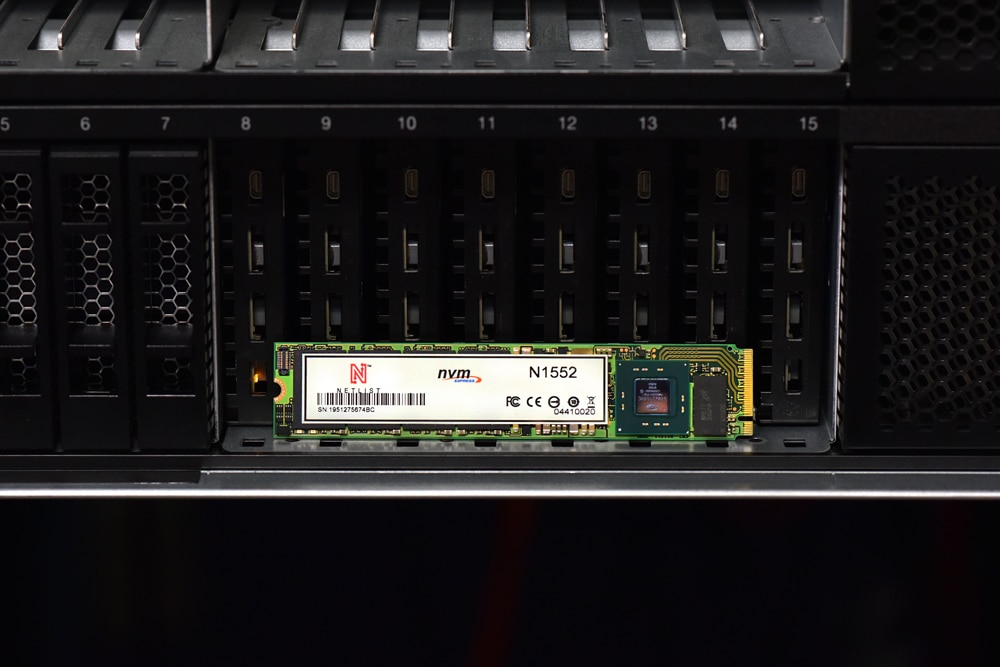
The Netlist NS1552 comes in an M.2 form factor but two sizes, the more common 2280 and the slightly larger 22110, known as the D4 and E4 series respectively. Both sizes leverage 96-lyaer 3D NAND. The D4 series run in capacity from 480GB up to 3.84TB with 1 DWPD. The E4 series runs in capacities from 400GB up to 3.2TB and has 3 DWPD for endurance. Aside from the endurance and capacity differences, the drives perform the same otherwise.
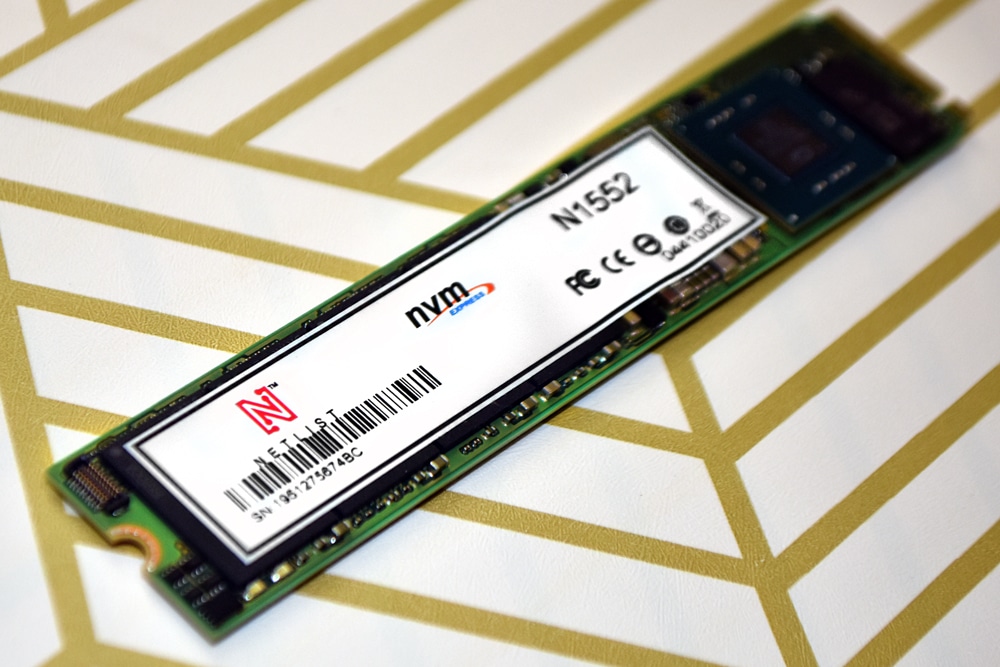
For performance the SSD is able to hit sequential read speeds as high as 3GB/s, sequential write as high as 1.5GB/s and sustained random read up to 440,000 IOPS. The drive claims read latency as low at 95μs read and 13μs write. As this is a performance per low power drive, the NS1552 has power consumption quoted at 8.25W maximum active and 3W in idle. The power can be throttle between 4.25W to 8.25W through flexible power management that users can control for dynamic workloads.
The NS1552 comes with several other features as well including power loss prevention (PLP) for data protection. Other data protection offered for the drive includes AES-256 data encryption and full data path protection. If uses need more overprovisioning or longer endurance, they can request it from Netlist.
For our review we are looking at the 3.2TB Netlist NS1552 E4.
Netlist NS1552 Specifications
| Models | D4-Series E4-Series | |
| From Factor | M.2 (2280/ 22110) | |
| Interface | PCIe Gen 3.0, x 4 Lane | |
| User Capacity | 480GB, 960GB, 1.92TB, 3.84TB | 400GB, 800GB, 1.6TB, 3.2TB |
| Endurance for 5 years | 1 DWPD | 3 DWPD |
| Sequential Read (128KB) | Up to 3.0 GB/s | |
| Sequential Write (128KB) | Up to 1.5 GB/s | |
| Sustained Random Read (4KB) | Up to 440 K IOPS | |
| Latency Read/Write | 95 / 13μs | |
| Power Consumption | Active Max: 8.25 W, Idle: 3W | |
| Temperature | Operating: 0-35°C, Non-Operating: -40~85°C | |
| UBER / MTBF | 1 sector per 10^17 read / 2 million hours | |
| NAND Flash Memory | 3D 96 Layer eTLC NAND | |
| Feature Support | PLP, Power Throttling, TRIM, AES-256 Data Encryption, Crypto Erase | |
| Customization Support | Over-provisioning & Longer Endurance, Extended Product Lifecycle Support | |
| Spec Compliance | PCI Express Gen3 Rev 3.0, NVM Express spec rev. 1.3 | |
Performance
Testbed
Our boot-drive Enterprise SSD reviews leverage a Dell PowerEdge R740xd for synthetic benchmarks. Synthetic tests that don’t require a lot of CPU resources use the more traditional dual-processor server. In both cases, the intent is to showcase local storage in the best light possible that aligns with storage vendor maximum drive specs.
Dell PowerEdge R740xd
- 2 x Intel Gold 6130 CPU (2.1GHz x 16 Cores)
- 4 x 16GB DDR4-2666MHz ECC DRAM
- 1x PERC 730 2GB 12Gb/s RAID Card
- Add-in NVMe Adapter
- Ubuntu-16.04.3-desktop-amd64
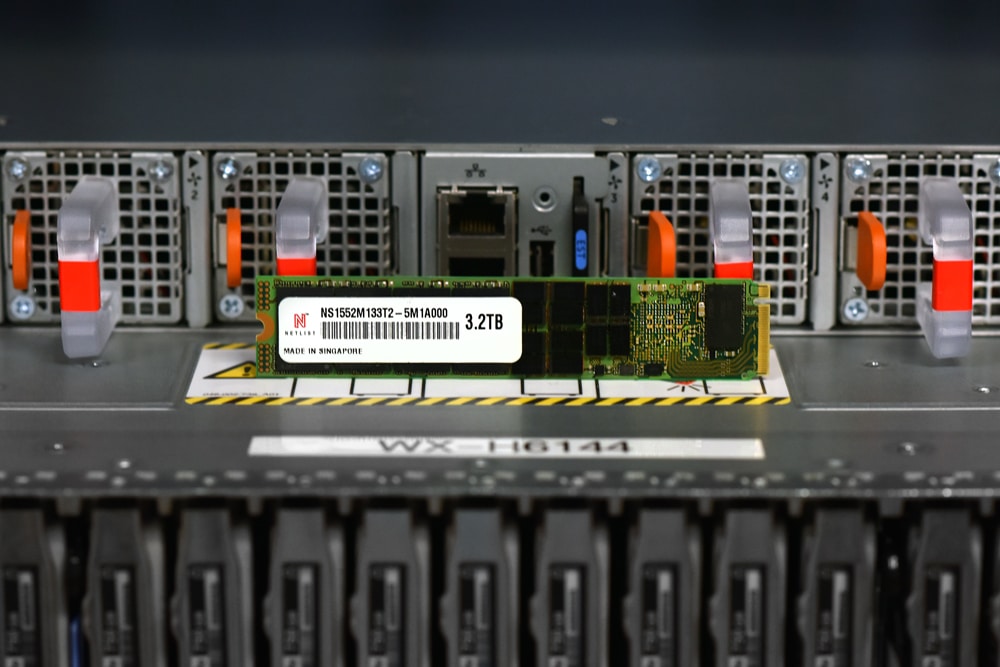
VDBench Workload Analysis
When it comes to benchmarking storage devices, application testing is best, and synthetic testing comes in second place. While not a perfect representation of actual workloads, synthetic tests do help to baseline storage devices with a repeatability factor that makes it easy to do apples-to-apples comparison between competing solutions. These workloads offer a range of different testing profiles ranging from “four corners” tests, common database transfer size tests, to trace captures from different VDI environments. All of these tests leverage the common vdBench workload generator, with a scripting engine to automate and capture results over a large compute testing cluster. This allows us to repeat the same workloads across a wide range of storage devices, including flash arrays and individual storage devices. Our testing process for these benchmarks fills the entire drive surface with data, then partitions a drive section equal to 5% of the drive capacity to simulate how the drive might respond to application workloads. This is different than full entropy tests which use 100% of the drive and take them into steady state. As a result, these figures will reflect higher-sustained write speeds.
Profiles:
- 4K Random Read: 100% Read, 128 threads, 0-120% iorate
- 4K Random Write: 100% Write, 64 threads, 0-120% iorate
- 64K Sequential Read: 100% Read, 16 threads, 0-120% iorate
- 64K Sequential Write: 100% Write, 8 threads, 0-120% iorate
For this review, we will be comparing the Netlist NS1552 to the Samsung 983 DCT, another M.2 SSD enterprise drive we have in the lab.
With our random 4K read the NS1552 peaked at second with 421,834 IOPS with a latency of 302µs.
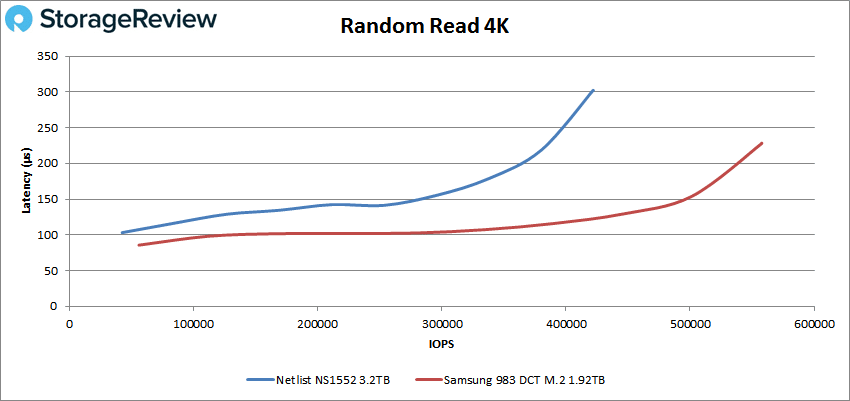
For 4K write the Netlist drive took first by a large margin with 187,874 IOPS with a latency of 678µs.
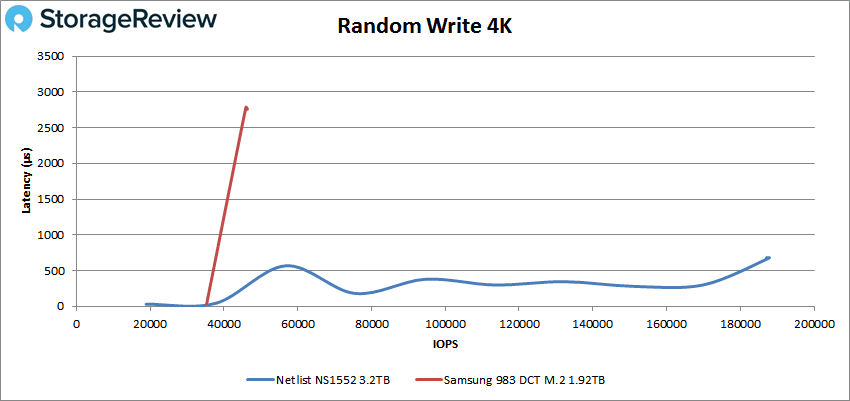
Switching over to sequential workloads, the Netlist SSD peaked in first with 35,356 IOPS or 2.2GB/s with a latency of 452µs in 64K read.
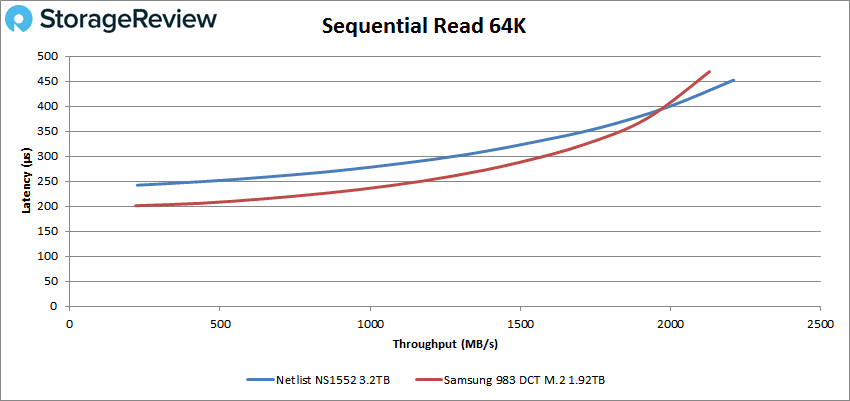
64K write again saw the Netlist take the top spot with a peak of 20,788 IOPS or 1.3GB/s at 535µs before dropping off some.
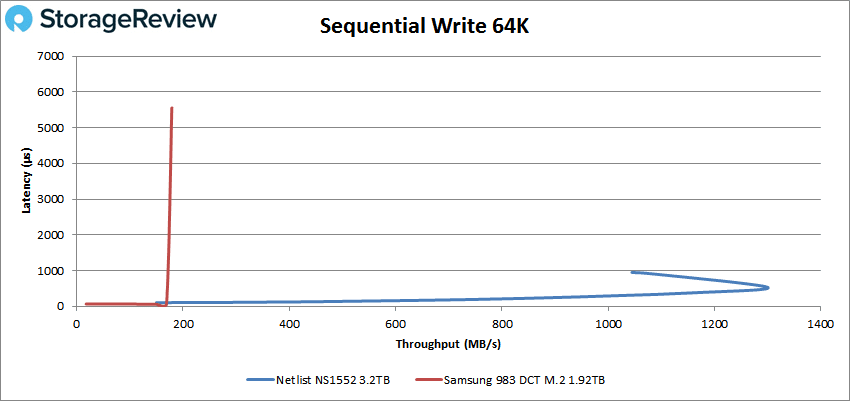
Next, we move on to our SQL workloads where the NS1552 fell to second with a peak performance of 157,060 IOPS and a latency of 203µs.
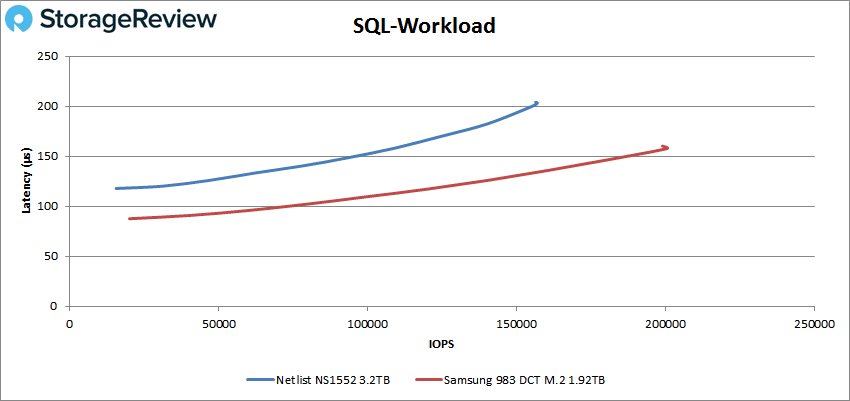
SQL 90-10 had a much closer run but the NS1552 fell to second again with a peak score of 163,634 IOPS and a latency of 195µs.
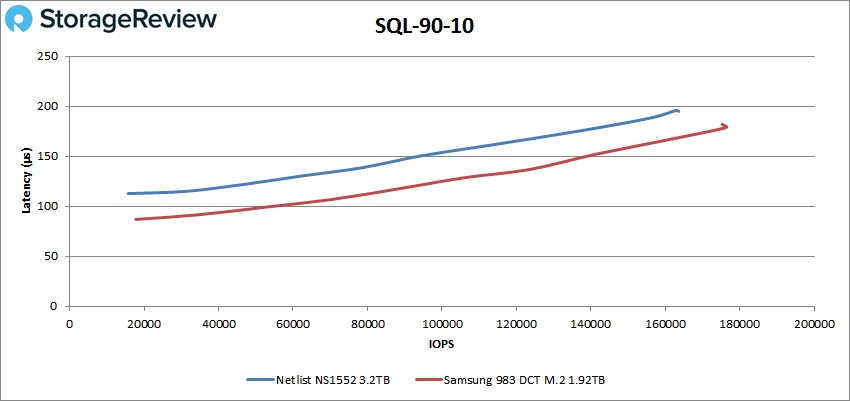
With SQL 80-20 the Netlist NS1552 took top spot with 146,883 IOPS with a latency of 217µs.
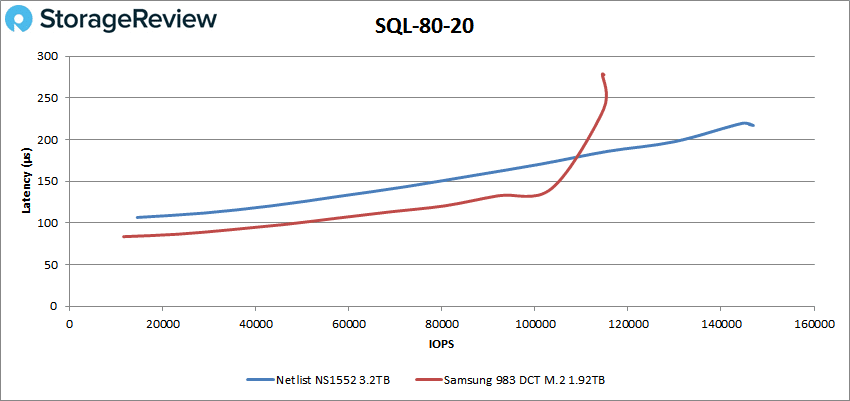
Moving on to Oracle workloads, the Netlist SSD starts off strong with the top performance of 149,900 IOPS and a latency of 236µs.
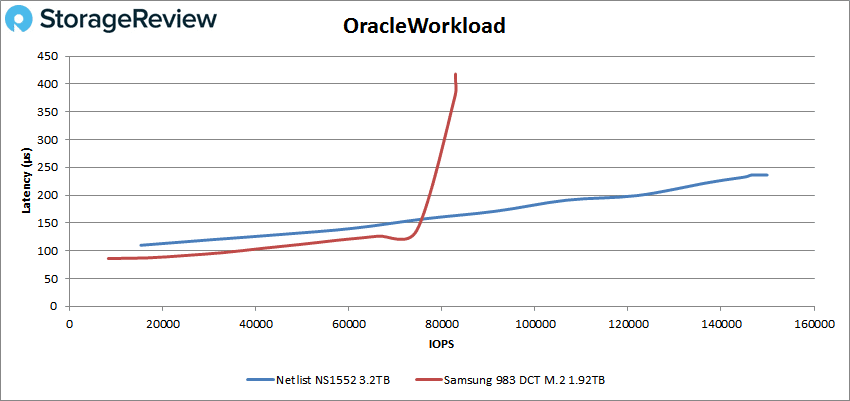
Oracle 90-10 saw a tight competition with the Netlist hitting second with a peak of 144,797 IOPS and a latency of 151µs.
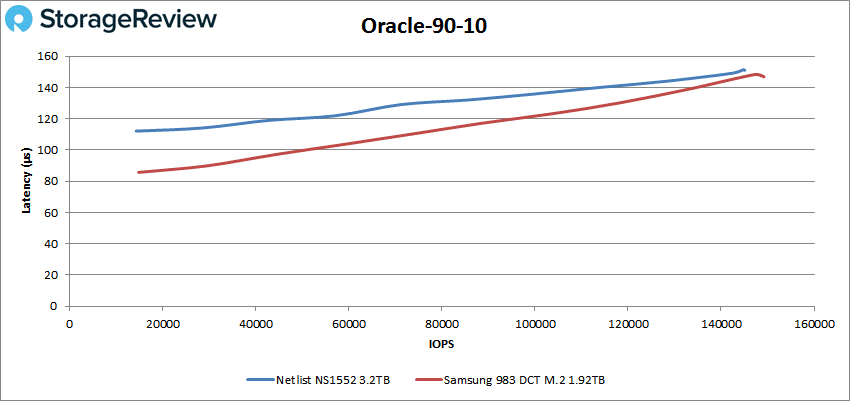
For Oracle 80-20 the NS1552 took the top spot once more with a peak of 134,445 IOPS and a latency of 163µs.
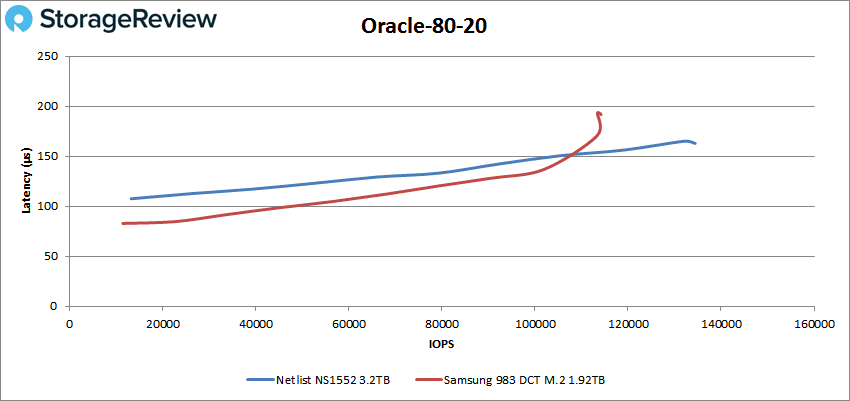
Next, we switched over to our VDI clone test, Full and Linked. For VDI Full Clone Boot, the Netlist NS1552 came in second with a peak of 109,761 IOPS with a latency of 316µs.
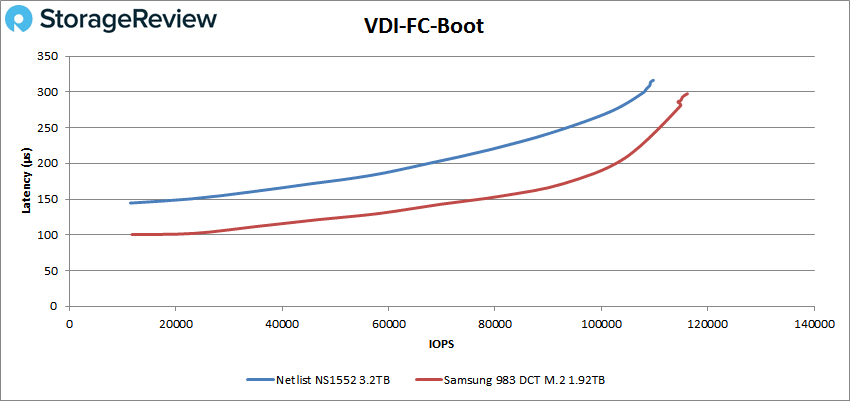
For VDI FC Initial Login saw the NS1552 jump way out in first with a peak of 62,046 IOPS and a latency of 466µs.
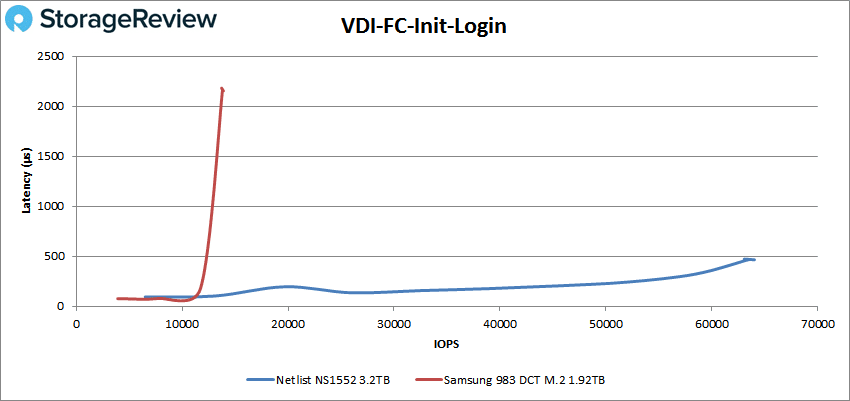
VDI FC Monday again had the Netlist way out in front with a score of 49,375 IOPS and a latency of 322µs.
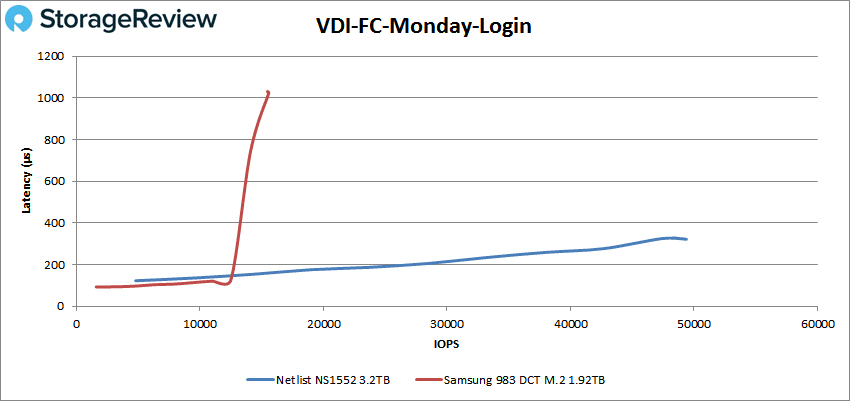
Next up is VDI Linked Clone. Starting with the boot the again the Netlist dropped to second with a peak of 58,281 IOPS and a latency of 274µs.
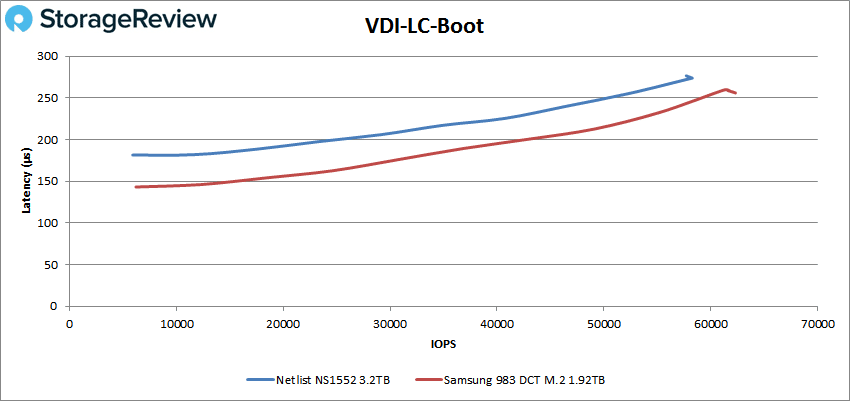
For VDI LC Initial Login the NS1552 jumped to first by a huge margin with 29,667 IOPS and a latency of 267µs.
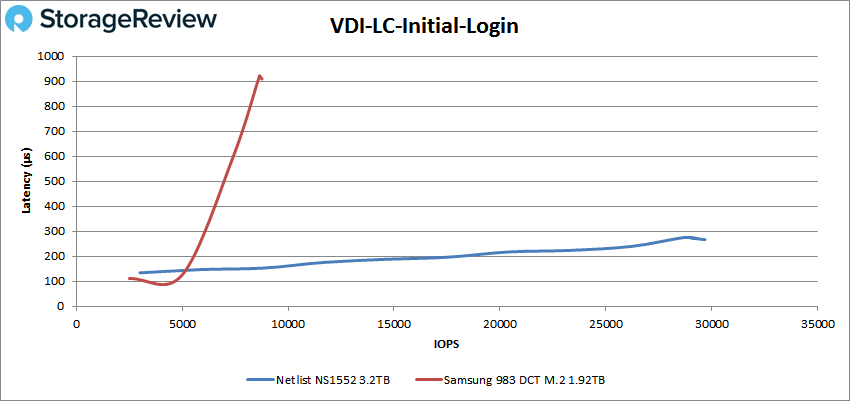
Finally with VDI LC Monday Login showed the Netlist NS1552 ahead by a large margin with a peak performance of 37,703 IOPS and a latency of 422µs.
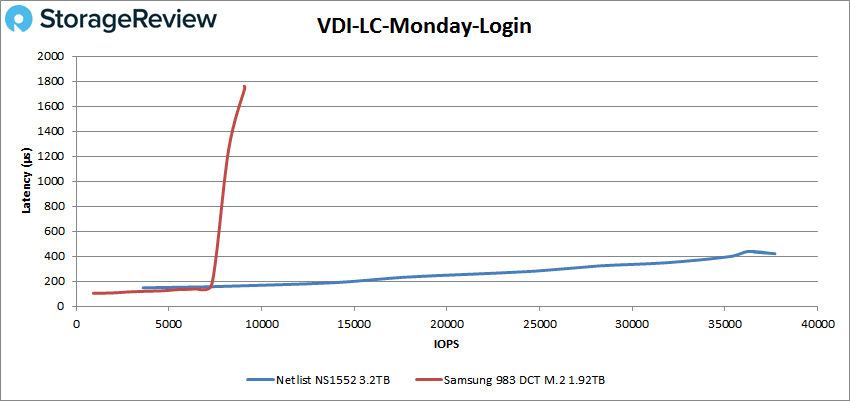
Conclusion
In addition to its other enterprise SSDs, this year saw the release of the Netlist NS1552 NVMe M.2 SSD. This drive comes in two M.2 sizes and up to 3.84TB of capacity. The drive is marketed as being a high-performance to low power consumption drive with max quoted speeds of 3GB/s and max power draw of 8.25W. The drive leverages 96-layer 3D NAND and is aimed at use cases such as boot and log information, searching, indexing, CDN, Cloud and hyper-scale computing, high-performance software-defined storage system, deep learning, big data analytics, high-performance storage systems, high-frequency trading, and online payment.
For performance we ran our VDBench workloads and compared it to a similar M.2 drive. Highlights include peaks of 422K IOPS for 4K read, 4K write saw 188K IOPS, 64K read hit 2.2GB/s, and 64K write peaked at 1.3GB/s. In our SQL test we saw 157K IOPS, 164K IOPS in SQL 90-10, and 147K IOPS in SQL 80-20. For Oracle the NS1552 peaked at 150K IOPS, 145K IOPS for Oracle 90-10, and 134K IOPS for Oracle 80-20. In our VDI clone tests (full and linked) we saw peaks of 110K IOPS in boot, 62K IOPS in Initial Login, and 49K IOPS in Monday Login for Full Clone. For Linked Clone we saw 58K IOPS for boot, 30K IOPS for Initial Login, and 38K IOPS for Monday Login.
The Netlist NS1552 M.2 SSD provides good performance at a low power draw for its given use cases. It has been nice to see an increase in vendor variety in our lab.




 Amazon
Amazon